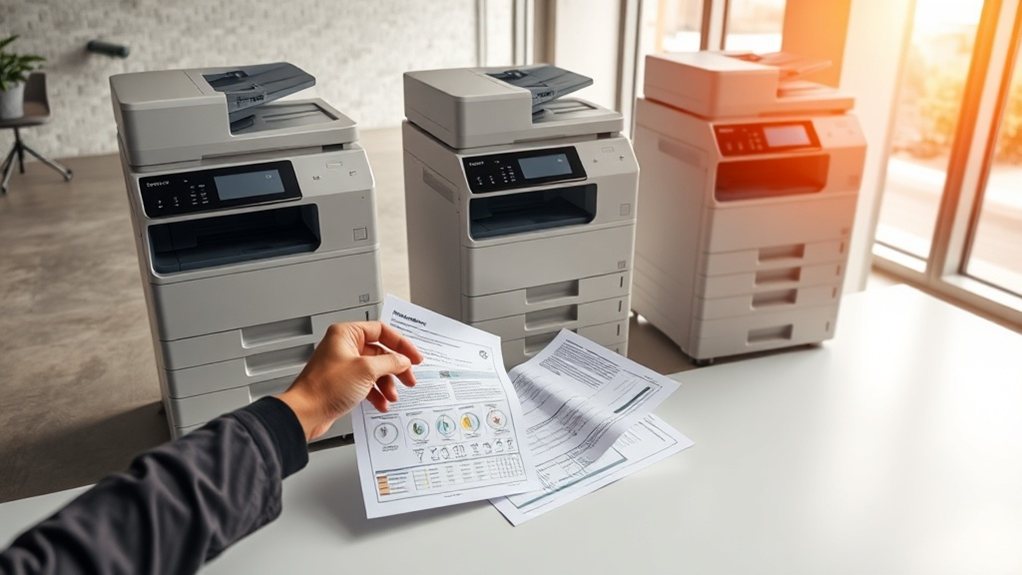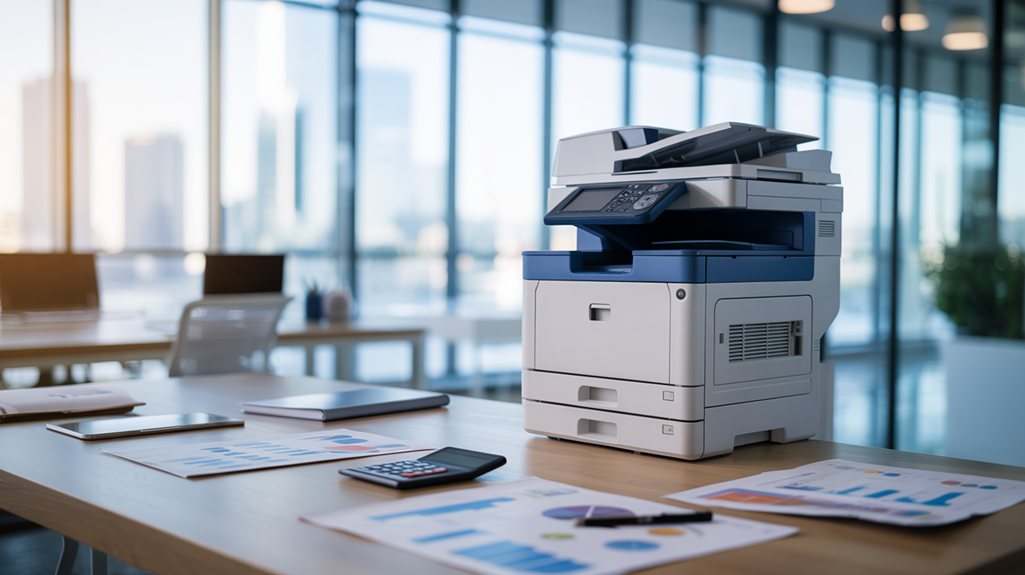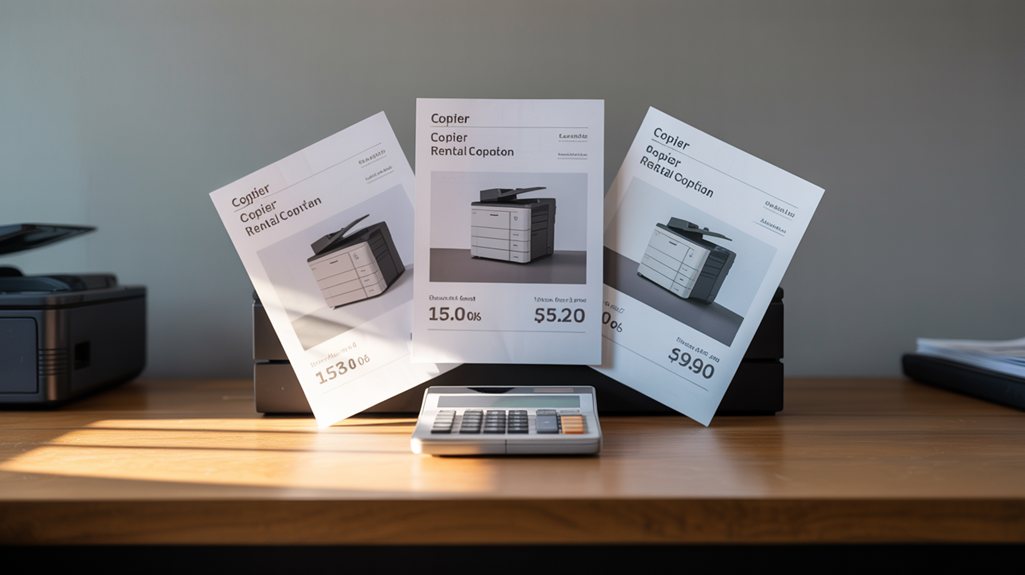
How to Choose a Cost-Effective Copier Rental for Your Business
Choosing a cost-effective copier rental means looking beyond the advertised monthly price, which often masks hidden fees like overage charges and maintenance costs that can increase expenses by 50%. Businesses should track actual monthly page volumes across departments, then compare itemized quotes from multiple providers based on total cost of ownership rather than individual line items. Equally important is selecting flexible lease terms with straightforward exit options and clearly defined service inclusions. Understanding these layers reveals the full financial picture and prevents costly mistakes.
Expert Highlights
- Track your monthly page volume across departments for three months to match equipment capacity to actual operational demand and prevent costly mistakes.
- Request itemized quotes detailing all expenses including maintenance, supplies, and overage charges to understand true cost of ownership, not just base rent.
- Compare total projected costs from multiple providers using identical specifications and your actual usage patterns, not individual line items or base prices.
- Negotiate flexible lease terms allowing equipment upgrades, downgrades, volume adjustments, and straightforward exit options with 30-60 days’ notice for operational changes.
- Clarify which consumables and maintenance are included versus charged separately, verify service response times, and negotiate installation and removal costs into the package.
Assessing Your Business Print Volume and Needs

How much does a business actually print each month, and does that volume match the equipment on hand? Most companies underestimate their printing needs, leading to inadequate equipment that causes bottlenecks and wasted employee time. Conversely, overestimating needs results in unnecessary rental costs and underutilized machines.
Businesses should track monthly page counts across all departments for three months to establish accurate baselines. This data reveals patterns: a law firm might need 50,000 pages monthly, while a tech startup requires only 5,000. Understanding these specific numbers prevents costly mistakes.
Once volume is determined, companies can select appropriately sized equipment. A machine rated for 20,000 monthly pages serves small offices efficiently, whereas high-volume operations require industrial-grade copiers. Matching equipment capacity to actual demand guarantees operational efficiency and cost savings.
Understanding the True Cost of Copier Leasing

Most businesses focus solely on the monthly lease payment when evaluating copier costs, but this surface-level approach masks the true financial picture underlying equipment rentals. Beyond base rent, hidden expenses considerably impact your budget: maintenance fees, supply costs, overage charges for exceeding page limits, and potential early-termination penalties. A copier leasing $300 monthly might actually cost $450 when including these additional factors.
To understand true costs, request itemized quotes detailing all expenses. Compare total cost of ownership across different lease terms and providers. Examine page-count limits carefully—exceeding them triggers expensive per-page charges. Calculate expected monthly printing volume and select appropriate tiers. This in-depth evaluation reveals which rental genuinely offers the best value, preventing budget surprises and enabling informed decision-making that aligns with actual business needs.
Comparing Quotes From Multiple Providers

Requesting quotes from at least three different copier rental companies reveals the significant price variations hidden within the equipment rental market, variations that can easily amount to hundreds of dollars monthly depending on how providers structure their fees and terms. When evaluating quotes, businesses should examine not just base rental costs but also per-page charges, maintenance coverage, and supply inclusions. A provider quoting $300 monthly might charge $0.02 per page, while another charges $0.015 with higher base rent. Comparing total projected costs based on actual usage patterns—rather than individual line items—prevents underestimating expenses. Obtaining identical specifications from each vendor guarantees meaningful comparison. This systematic approach identifies which provider delivers genuine value aligned with operational needs and budget constraints.
Evaluating Lease Terms and Contract Flexibility
Beyond securing competitive pricing, businesses must scrutinize the actual terms governing their copier rental agreements, since contract flexibility often determines whether a rental arrangement remains advantageous as operational demands shift. Companies face the challenge of being locked into rigid contracts that don’t accommodate growth or downsizing. The solution involves negotiating terms allowing equipment upgrades, downgrades, or early termination without excessive penalties. Examine clauses regarding maintenance responsibilities, supply coverage, and service response times. Request provisions permitting volume adjustments quarterly or annually. Prioritize contracts with straightforward exit options, typically requiring 30-60 days’ notice rather than years of commitment. This flexibility protects businesses from overpaying for unused capacity or undersized equipment, ensuring the rental agreement evolves alongside changing workplace needs and budgetary constraints.
Identifying Hidden Fees and Service Inclusions
When evaluating copier rental agreements, businesses often encounter unexpected expenses that extend beyond the quoted monthly rate, including consumables like toner and paper, overage charges when usage exceeds contractual limits, and fees for installation, removal, or relocation services. Understanding what’s covered under maintenance and support—such as routine servicing, emergency repairs, and technician response times—separates truly affordable options from those with hidden costs that accumulate over the rental period. By carefully reviewing which items are included versus which incur additional charges, companies can accurately predict total ownership costs and avoid budget surprises that compromise their cost-effectiveness goals.
Consumables and Overage Charges
How many businesses discover unexpected charges on their copier rental invoices only after committing to multi-year contracts? Consumables like toner, drums, and maintenance parts frequently carry hidden costs that aren’t clearly outlined in initial agreements. Overage charges apply when businesses exceed their monthly page allowance—sometimes costing $0.03 to $0.10 per extra page, which accumulates quickly for high-volume operations.
The solution involves requesting itemized breakdowns before signing contracts. Businesses should clarify what consumables are included versus what incurs additional fees. Negotiating a higher page allowance upfront often costs less than paying overages later. Understanding per-page overage rates and establishing realistic monthly usage projections guarantees financial surprises are avoided. This transparency protects budgets and safeguards rental agreements align with actual operational needs and expenses.
Maintenance and Support Coverage
Most copier rental agreements include maintenance clauses that sound all-encompassing on the surface, yet businesses frequently discover critical service gaps only after equipment failures disrupt operations. Many contracts exclude specific components like fusers or paper feeders, leaving companies responsible for expensive repairs. To protect your business, request detailed maintenance schedules specifying which parts are covered and response time guarantees—typically four to eight hours for critical breakdowns. Verify whether toner, drum units, and imaging components fall under included maintenance or require separate charges. Ask about service level agreements that outline technician availability during your business hours. Comprehending these distinctions prevents unexpected costs and guarantees your equipment remains operational when you need it most, safeguarding productivity and protecting your bottom line.
Installation and Removal Costs
Installation and removal charges represent one of the most overlooked expenses in copier rental agreements, often appearing as seemingly minor line items that accumulate into substantial costs by contract’s end. Many businesses discover that setup fees, delivery charges, and decommissioning costs weren’t clearly outlined initially, resulting in unexpected financial burdens.
The solution lies in requesting detailed breakdowns before signing contracts. Reputable rental companies should provide transparent pricing that includes installation, removal, and site preparation within their base fees. Negotiating these costs into the rental package eliminates surprises and simplifies budgeting. Comparing multiple vendors’ complete service inclusions—not just monthly rates—reveals true total costs. Understanding what’s covered versus what’s extra empowers businesses to make informed decisions, protect their bottom line, and avoid costly contract misunderstandings that strain operations and finances.
Negotiating Better Rates and Discounts
Businesses can strengthen their negotiating position by demonstrating a commitment to higher volume orders or longer lease terms, since vendors typically reward loyalty with substantial rate reductions that offset the initial commitment. Timing your lease renewal strategically—such as negotiating during vendor quarterly promotions or when your contract nears expiration—creates competitive pressure that often results in better pricing and enhanced service packages without requiring you to switch providers. These two approaches combined allow organizations to reduce monthly copier costs by 15-30%, making the difference between a sustainable rental budget and one that strains operational resources.
Leverage Volume and Commitment
When organizations commit to renting multiple copiers or signing longer-term agreements, they access the ability to negotiate substantially better pricing from equipment providers—a leverage point that many companies overlook despite its considerable impact on annual expenses.
Businesses holding substantial negotiating power can secure meaningful discounts by demonstrating their commitment through volume purchases or extended contracts. Consider these strategic approaches:
- Multi-unit commitments reduce per-machine costs notably, as providers prefer predictable, larger revenue streams
- Extended contract terms (3-5 years) incentivize vendors to offer lower monthly rates in exchange for stability
- Bundled services combining equipment rental with maintenance and supplies create inclusive savings packages
Companies that consolidate their copier needs into single agreements rather than fragmented purchases gain competitive advantages. Equipment providers reward loyalty through tiered pricing structures, ensuring businesses maximize their rental investments while maintaining operational efficiency.
Timing Your Lease Renewal
Strategic timing of lease renewals represents one of the most underutilized opportunities for companies to negotiate substantial rate reductions, yet many organizations passively accept vendor renewal quotes without recognizing their negotiating position strengthens considerably as renewal dates approach. When leases near expiration, copier vendors face genuine risk of losing established clients to competitors, creating leverage businesses can exploit effectively.
Companies should initiate renewal discussions 90 days before expiration, signaling willingness to explore alternative providers. This timing creates urgency for vendors motivated to retain profitable accounts. Armed with competitive quotes from other suppliers, businesses can demand price reductions, equipment upgrades, or enhanced service terms. Organizations that implement this strategy typically secure 15-25% savings compared to passive renewal acceptance, directly improving operational budgets while maintaining reliable document management capabilities throughout their facilities.
Monitoring Usage to Prevent Overage Charges
Most copier rental agreements include a set monthly page allowance, and exceeding this limit triggers costly overage fees that can quickly erode the savings from renting rather than purchasing equipment outright. Businesses often underestimate their printing needs, leading to unexpected charges that accumulate throughout the lease term.
Implementing monitoring strategies prevents these financial surprises:
- Track page counts regularly by reviewing machine reports and comparing them against your monthly allowance, identifying usage patterns early
- Establish departmental guidelines that encourage employees to print strategically, reducing unnecessary copies and waste
- Schedule quarterly reviews with your rental provider to adjust page limits before overage fees occur
Regular monitoring transforms printing from an uncontrolled expense into a predictable budget line item. Businesses gain visibility into consumption habits, enabling informed decisions about future rental agreements and cost optimization opportunities.
Frequently Asked Questions
What Happens if My Business Needs Change During the Lease Term?
Most copier rental agreements include modification clauses allowing businesses to upgrade, downgrade, or adjust equipment during the lease term. Companies typically contact their provider to discuss changes, which may involve adjusting monthly payments accordingly.
Are Copier Leases Tax-Deductible for My Business?
Business copier lease payments are typically tax-deductible as operating expenses. Companies should consult their accountant to confirm eligibility, as deductibility depends on specific business structure and lease terms.
Can I Upgrade to a Newer Model Before My Lease Ends?
Most copier lease agreements permit mid-term upgrades to newer models, though terms vary by provider. Businesses should review their specific contract for upgrade policies, potential fees, and replacement timelines before requesting equipment changes.
What Insurance Coverage Do Leasing Companies Typically Require?
Leasing companies typically require thorough coverage protecting against damage, theft, and liability. Most demand equipment insurance naming the lessor as loss payee. Some allow businesses to maintain coverage through existing policies if limits meet specified minimums.
How Do I Handle Equipment Damage or Malfunctions During the Lease?
Most leasing agreements include maintenance coverage that addresses equipment malfunctions through the provider’s service teams. Damage responsibility typically depends on lease terms; accidental damage may require deductibles or additional fees, while normal wear qualifies for covered repairs.
Expert Final Thoughts
Selecting a cost-effective copier rental requires careful planning and thorough comparison. By evaluating print volume, understanding lease structures, gathering multiple quotes, and scrutinizing contracts for hidden fees, businesses can make informed decisions that reduce expenses. Negotiating rates and monitoring usage prevents overage charges, ensuring the rental remains profitable long-term. Taking time to inspect options upfront protects the bottom line while securing equipment that matches operational needs.